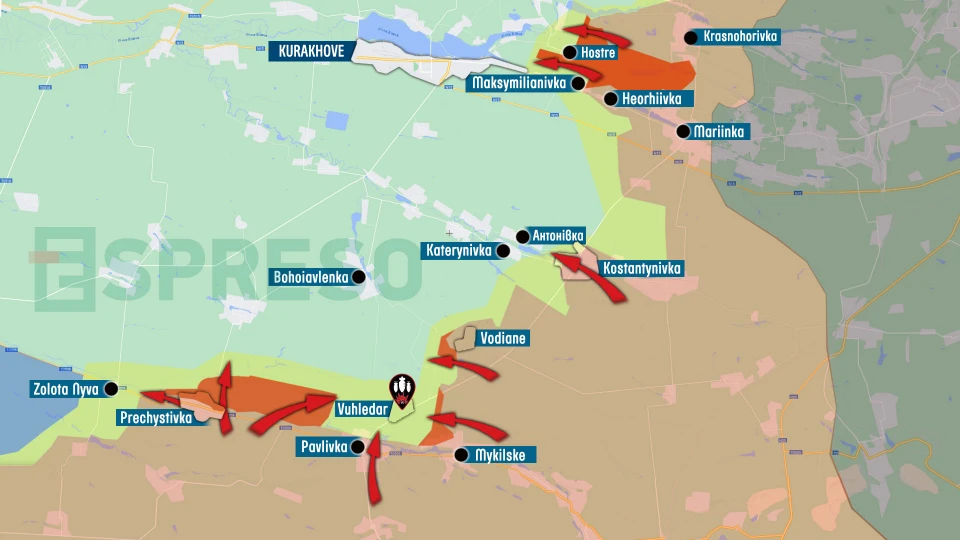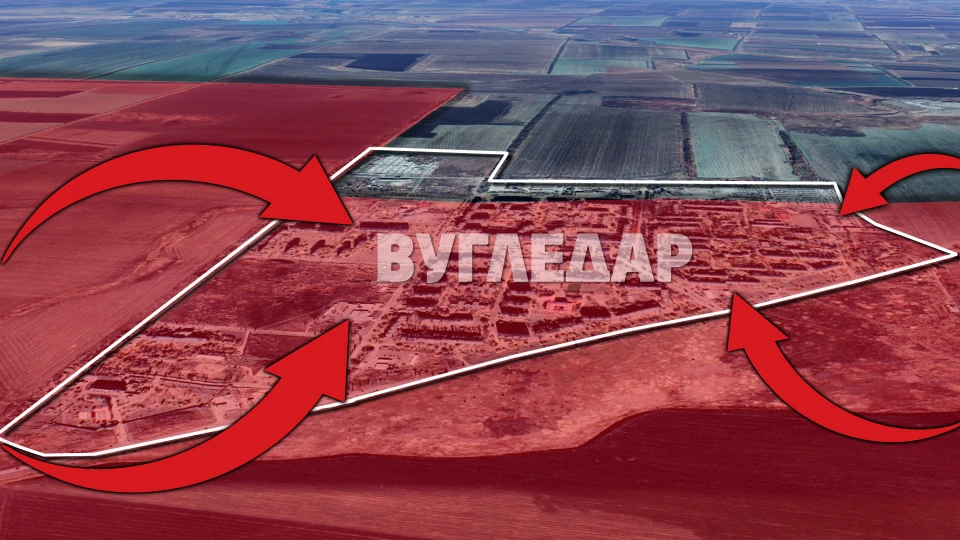
Ukraine's withdrawal from Vuhledar: first conclusions and consequences. Serhiy Zgurets' column
It is necessary to draw conclusions on how to counter Russian flanking encirclements, as they frequently recur across the front
First of all, on behalf of the Defense Express team, I would like to congratulate you on the Christian holiday of the Intercession and the Day of Defenders, who perform miracles on the front line, holding back a much larger enemy force, and show miracles of courage and endurance when leaving cities or positions that simply cannot be held any longer.
Vuhledar situation
I will talk about Vuhledar, which we have mentioned many times, where the situation is changing quite rapidly.

On the morning of October 1, we saw a report from the General Staff of the Ukrainian Armed Forces that the Russian aggressor had launched eight assault attacks in the direction of Vuhledar, using attack and bombing aircraft. During the day, we already saw reports that the Russian forces entered Vuhledar from the west and south. There were hostile videos of the enemy moving around the outskirts of the town.

At the moment, we can say that Russian troops are in the center of Vuhledar, but rearguard battles are taking place. That is, battles when units carry out a planned retreat from their positions. We know that for 2 years, 1 month and 15 days Vuhledar was defended by the 72nd Separate Mechanized Brigade, which is now withdrawing from the town.
So far, there has been no official confirmation from the Ukrainian General Staff and there probably won't be. However, we understand that the Russians tried to surround the Ukrainian brigade in this town from the west and east, and they failed. However, we know that it is extremely difficult to retreat to Bohoiavlenka. This is one of the routes along which we are retreating, along with some dirt roads, and the Russians are trying to put fire pressure on Ukrainian forces. However, we can say that during this time the 72nd Brigade has demonstrated miracles of courage, holding this difficult foothold.
Of course, now we have to talk about what might happen next, that is, after the Russian troops capture Vuhledar, when Ukrainian troops will completely withdraw, because it is really impossible to hold it now. There is no collapse of the defense, because there is another defensive line in the area of Novoukrainka and Bohoiavlenka.
To improve the situation, we need to withdraw troops, regroup and continue to hold the line. Of course, it's harder to hold the line in the conditions where there is a new defense line. We are moving beyond the urban areas, and then it's fall and winter, so it's usually better to be in the cities rather than in the field in such conditions.
We also know that control of Vuhledar will improve the Russian logistics if it ensures the operation of the railroad through Volnovakha. This will make it easier for the enemy to supply the Dnipro and East troops, which is one of the challenges that is now emerging after the change on the battlefield.
But we realize that this is not the last battle and not the last fight. We need to draw some conclusions as to why this happened. When this bridgehead was held for two years, and starting around August 30, things began to deteriorate. Of course, we can talk about the superiority of the Russian forces. When we talk about brigades, the Russian advantage was 1 to 5, that is, there were 5 Russian brigades against one of Ukrainian brigades. But if we calculate the number of personnel, the advantage was 1 to 10, and sometimes 1 to 12. This is the advantage that influenced the constant assaults and the exhaustion of Ukrainian troops. There is also a Russian advantage in artillery and guided bombs, and we know this as well.
However, we need to draw conclusions on how to counter Russian flanking encirclement, because it has become a constant example that is repeated from time to time in many parts of the front. The issues of timely reinforcement of Ukrainian units, personnel policy, and the change of brigade commanders at a crucial moment - all of this did not contribute to effective defense measures. So there are a lot of issues, but we understand that the soldiers of the 72nd Brigade have fulfilled their task. And this will serve as an example of how to ensure the defense of such difficult frontline areas.
Personnel changes in the Defense Ministry
At the same time, we know that the consequences of the retreat from Vuhledar include delays in the supply of Ukrainian weapons, delays in mobilization and other measures that have affected the potential of Ukrainian brigades on the front line. Yesterday, the Minister of Defense made a decision to replace a number of Deputy Ministers of Defense. The Cabinet of Ministers supported the dismissal and replacement of two of the four deputy ministers. I think this story will continue. The Minister of Defense also announced that there will be improvements and changes related to the procurement of weapons.
“Special exporters”, including Spetstechnoexport, which was under the Defence Intelligence of Ukraine, are being transferred under the Ministry of Defense. We will also improve the work of the Defense Procurement Agency, which purchases weapons from our partners abroad and from our manufacturers. Supervisory boards will also be established in the Defense Procurement Agency and in the structure responsible for the procurement of non-military property. But supervisory boards are only one element of improvement, which is not always decisive.
Ukraine's defense industry cooperation with foreign partners
This week, Kyiv is hosting a number of events that are not public, but are extremely important: meetings between foreign and Ukrainian arms manufacturers to find common ground in a new format.
Pavlo Verkhniatskyi, director and managing partner of COSA, co-coordinator of the US-Ukraine Business Council (USUBC) Security and Aerospace Working Group, said that such events are held consistently and have been held several times, so there is some progress. Firstly, more foreign participants have arrived in Ukraine, i.e. more companies and representatives of industries. Secondly, in a qualitative sense, we see that companies that came to Ukraine a year and a half ago have already made some progress in cooperation with Ukrainian partners. Foreign colleagues are already working on joint projects with Ukrainian manufacturers. There are serious contracts that have been announced publicly. And there are also a number of non-public projects that we know about, and they are moving quite well. As for repair projects, they are developing the fastest, but there are high-tech aspects in which our partners are not ready to share everything with us.
COSA's Director and Managing Partner said: “Our partners understand that their production rates do not meet modern challenges. And in order to accelerate this pace, they need to produce not everything in their country. Therefore, they have a certain willingness to cooperate with partners around the world, including Ukraine. This means that they are ready to gradually ease regulations in terms of technology transfer. These are serious steps, because these changes have not taken place for about 30 years.
The USUBC Co-Coordinator added that the security challenge of potential attacks on enterprises that could be under construction or already have existing facilities is one of the key issues that our partners are thinking about. Because no one wants to build a serious production facility to be attacked later. As for specific challenges, such as interaction with law enforcement agencies, corruption, and so on, our partners do not talk about such reservations anymore. There is a certain bureaucratic history, where not everything can move quickly on the Ukrainian side to adapt our regulatory framework to theirs. But this is actually a two-way street, because the partner side has a lot to do to simplify cooperation with Ukraine. For the partners, the biggest problem is still a lack of understanding of how big this market will be and how much products made in Ukraine can be sold to third countries.
Verkhniatskyi noted that any drastic and abrupt personnel changes in leadership positions cannot have a positive impact on international relations. “Steps are built for each project and mechanism, and this is bureaucracy on both sides. Accordingly, when certain steps are developed, relationships are established, mechanisms are developed with specific teams that initiate and implement certain things, and then it is interrupted halfway through, it definitely does not have a good effect. We have seen such stories before, in the context of not only the Ministry of Defense but also other agencies. Therefore, drastic changes of this kind do not have a positive impact, but we will see what personnel changes in the Ministry of Defense will lead to, because change is not always bad.
- News













































